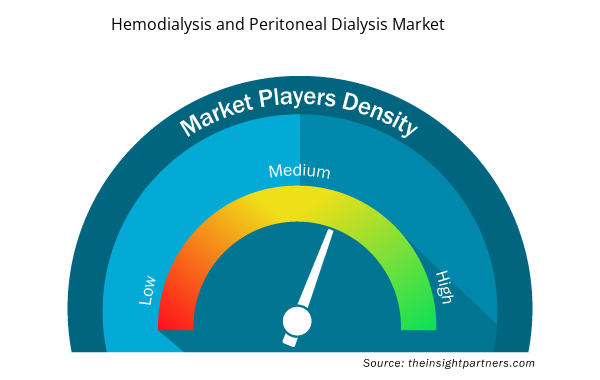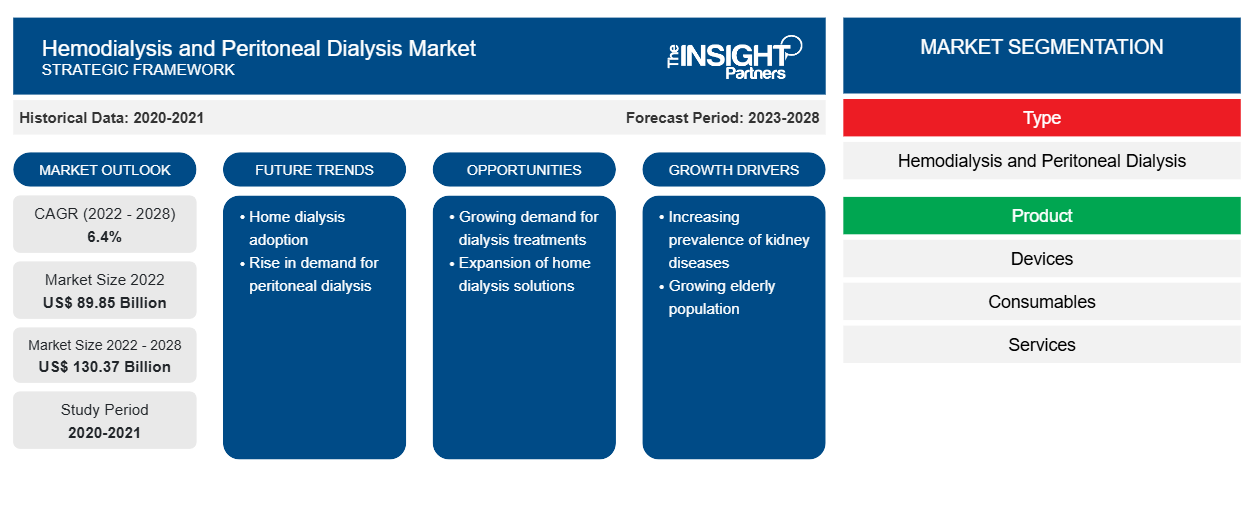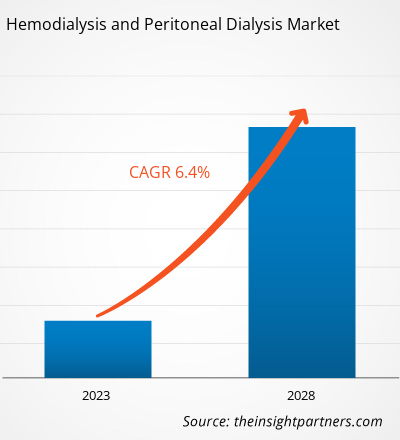Se proyecta que el mercado de hemodiálisis y diálisis peritoneal alcance los US$ 130.370,18 millones para 2028 desde los US$ 89.851,61 millones en 2022; se espera que crezca a una CAGR del 6,4% entre 2022 y 2028.
Existen dos tipos de diálisis. En la hemodiálisis, la sangre se bombea desde el cuerpo del paciente a una máquina de riñón artificial y se devuelve al cuerpo del paciente mediante tubos conectados a las máquinas. En la diálisis peritoneal , el revestimiento interno del abdomen del propio paciente actúa como un filtro natural.
El mercado de hemodiálisis y diálisis peritoneal está segmentado en función del tipo, el producto, el usuario final y la geografía. Por geografía, el mercado está ampliamente segmentado en América del Norte, Europa, Asia Pacífico, Oriente Medio y África, y América del Sur y Central. El informe de mercado de hemodiálisis y diálisis peritoneal ofrece información y un análisis profundo del mercado, haciendo hincapié en parámetros como el tamaño del mercado, las tendencias, los avances tecnológicos y la dinámica del mercado, así como el análisis del panorama competitivo de los principales actores del mercado a nivel mundial. Además, el informe incluye el impacto de la pandemia de COVID-19 en el mercado de hemodiálisis y diálisis peritoneal en todas las regiones.
El crecimiento del mercado de hemodiálisis y diálisis peritoneal se atribuye al aumento del número de pacientes con enfermedad renal en etapa terminal, al aumento de la incidencia de insuficiencia renal y disfunción renal crónica entre la población y a la escasez de donantes de órganos. Sin embargo, las preocupaciones sobre el reembolso en los mercados emergentes limitan el crecimiento del mercado.
Personalice este informe según sus necesidades
Obtendrá personalización en cualquier informe, sin cargo, incluidas partes de este informe o análisis a nivel de país, paquete de datos de Excel, así como también grandes ofertas y descuentos para empresas emergentes y universidades.
- Obtenga las principales tendencias clave del mercado de este informe.Esta muestra GRATUITA incluirá análisis de datos, desde tendencias del mercado hasta estimaciones y pronósticos.
Perspectivas del mercado
La creciente prevalencia de enfermedades renales impulsa el crecimiento del mercado de hemodiálisis y diálisis peritoneal
La enfermedad renal crónica (ERC) y la lesión renal aguda (LRA) son afecciones en las que los riñones están dañados y no pueden filtrar la sangre adecuadamente. Debido a esto, el exceso de líquido y desechos de la sangre permanecen en el cuerpo, lo que puede causar otros problemas de salud como enfermedades cardíacas y accidentes cerebrovasculares. La ERC generalmente empeora con el tiempo, aunque el tratamiento ha demostrado una progresión lenta. Si la ERC no se trata, puede progresar a insuficiencia renal y enfermedad cardiovascular temprana. En la ERC, cuando los riñones dejan de funcionar, se necesita diálisis o trasplante de riñón para sobrevivir. Cuando se trata con diálisis o trasplante de riñón, esta insuficiencia renal se llama enfermedad renal en etapa terminal (ESRD). Según los Centros para el Control y la Prevención de Enfermedades (CDC), aproximadamente 36 millones de adultos padecen ERC en los EE. UU. Además, cada 24 horas, 360 personas comienzan un tratamiento de diálisis por insuficiencia renal. En 2017, se registraron 697,5 millones de casos de ERC (en todas las etapas) en todo el mundo, lo que representa una prevalencia global del 9,1%. La creciente prevalencia de la enfermedad renal terminal (ESRD, por sus siglas en inglés) es también uno de los principales factores que impulsan el mercado. Por ejemplo, según el Sistema de Datos Renales de los Estados Unidos (USRDS, por sus siglas en inglés), casi 786.000 personas en el país viven con enfermedad renal terminal (ESKD, por sus siglas en inglés), también conocida como enfermedad renal en etapa terminal (ESRD, por sus siglas en inglés). Por lo tanto, la creciente prevalencia de la enfermedad renal crónica, la lesión renal aguda y la enfermedad renal en etapa terminal, que conduce a la condición de diálisis, está impulsando el mercado de la hemodiálisis y la diálisis peritoneal.
Perspectivas basadas en tipos
Según el tipo, el mercado de hemodiálisis y diálisis peritoneal se divide en hemodiálisis y diálisis peritoneal. En 2022, el segmento de hemodiálisis tuvo una mayor participación en el mercado. Además, se espera que el mismo segmento registre una CAGR más alta del 6,7 % durante el período de pronóstico.
Perspectivas basadas en productos
Según el producto, el mercado de hemodiálisis y diálisis peritoneal se segmenta en dispositivos, consumibles y servicios. El segmento de servicios tuvo la mayor participación de mercado en 2022. Sin embargo, se prevé que el segmento de consumibles registre la CAGR más alta del 7,5 % durante el período de pronóstico.
Información basada en el usuario final
Según el usuario final, el mercado de hemodiálisis y diálisis peritoneal se segmenta en hospitalario y domiciliario. El segmento hospitalario tuvo una participación mayor en 2022. Sin embargo, se espera que el segmento domiciliario registre una CAGR más alta del 7,4 % durante el período de pronóstico.
Los actores del mercado de hemodiálisis y diálisis peritoneal adoptan estrategias orgánicas, como el lanzamiento y la expansión de productos, para expandir su presencia y cartera de productos en todo el mundo, así como para satisfacer las crecientes demandas.
Perspectivas regionales del mercado de hemodiálisis y diálisis peritoneal
Los analistas de Insight Partners explicaron en detalle las tendencias y los factores regionales que influyen en el mercado de hemodiálisis y diálisis peritoneal durante el período de pronóstico. Esta sección también analiza los segmentos y la geografía del mercado de hemodiálisis y diálisis peritoneal en América del Norte, Europa, Asia Pacífico, Oriente Medio y África, y América del Sur y Central.

- Obtenga datos regionales específicos para el mercado de hemodiálisis y diálisis peritoneal
Alcance del informe de mercado de hemodiálisis y diálisis peritoneal
| Atributo del informe | Detalles |
|---|---|
| Tamaño del mercado en 2022 | US$ 89.85 mil millones |
| Tamaño del mercado en 2028 | US$ 130,37 mil millones |
| CAGR global (2022-2028) | 6,4% |
| Datos históricos | 2020-2021 |
| Período de pronóstico | 2023-2028 |
| Segmentos cubiertos | Por tipo
|
| Regiones y países cubiertos | América del norte
|
| Líderes del mercado y perfiles de empresas clave |
|
Densidad de actores del mercado de hemodiálisis y diálisis peritoneal: comprensión de su impacto en la dinámica empresarial
El mercado de hemodiálisis y diálisis peritoneal está creciendo rápidamente, impulsado por la creciente demanda de los usuarios finales debido a factores como la evolución de las preferencias de los consumidores, los avances tecnológicos y una mayor conciencia de los beneficios del producto. A medida que aumenta la demanda, las empresas amplían sus ofertas, innovan para satisfacer las necesidades de los consumidores y aprovechan las tendencias emergentes, lo que impulsa aún más el crecimiento del mercado.
La densidad de actores del mercado se refiere a la distribución de las empresas o firmas que operan dentro de un mercado o industria en particular. Indica cuántos competidores (actores del mercado) están presentes en un espacio de mercado determinado en relación con su tamaño o valor total de mercado.
Las principales empresas que operan en el mercado de hemodiálisis y diálisis peritoneal son:
- Fresenius Medical Care AG & Co. KGaA (Agencia de Medicamentos y Productos Sanitarios)
- DaVita Inc.
- Baxter Internacional Inc.
- B. Braun Melsungen AG
- Diavero
Descargo de responsabilidad : Las empresas enumeradas anteriormente no están clasificadas en ningún orden particular.

- Obtenga una descripción general de los principales actores clave del mercado de hemodiálisis y diálisis peritoneal
Por geografía
Según la geografía, el mercado de hemodiálisis y diálisis peritoneal está segmentado en América del Norte (Estados Unidos, Canadá y México), Europa (Reino Unido, Alemania, Francia, Italia, España y el resto de Europa), Asia Pacífico (China, Japón, India, Australia, Corea del Sur y el resto de Asia Pacífico), Oriente Medio y África (EAU, Arabia Saudita, Sudáfrica y el resto de Oriente Medio y África) y América del Sur y Central (Brasil, Argentina y el resto de América del Sur y Central). Algunos de los principales actores que participan en el mercado son Fresenius Medical Care AG & Co KGaA; DaVita Inc.; Baxter International Inc.; B. Braun Melsungen AG; Diaverum; Nipro Medical Corporation; Asahi Kasei Medical Co., Ltd.; Rockwell Medical, Inc.; y Dialife SA.
- Análisis histórico (2 años), año base, pronóstico (7 años) con CAGR
- Análisis PEST y FODA
- Tamaño del mercado Valor/volumen: global, regional, nacional
- Industria y panorama competitivo
- Conjunto de datos de Excel


- Collagen Peptides Market
- Sandwich Panel Market
- Biopharmaceutical Contract Manufacturing Market
- Constipation Treatment Market
- Small Internal Combustion Engine Market
- Third Party Logistics Market
- Dry Eye Products Market
- Artwork Management Software Market
- Asset Integrity Management Market
- Green Hydrogen Market

Report Coverage
Revenue forecast, Company Analysis, Industry landscape, Growth factors, and Trends

Segment Covered
This text is related
to segments covered.

Regional Scope
North America, Europe, Asia Pacific, Middle East & Africa, South & Central America

Country Scope
This text is related
to country scope.
Preguntas frecuentes
Global hemodialysis and peritoneal dialysis market is segmented by region into North America, Europe, Asia Pacific, Middle East & Africa and South & Central America. In North America, the U.S. is the largest market for transport media. The US is estimated to hold the largest share in the hemodialysis and peritoneal dialysis market during the forecast period. The rising prevalence of chronic kidney disease and healthcare spending by Medicare contributes to the market's growth. However, the prevalence of chronic kidney disease (CKD) that demands promising diagnostic test options in the Asia-Pacific is expected to account for the fastest growth of the region during the coming years
The hemodialysis and peritoneal dialysis market majorly consists of the players such as Fresenius Medical Care AG & Co KGaA; DaVita Inc.; Baxter International Inc.; B. Braun Melsungen AG; Diaverum; Nipro Medical Corporation; Evoqua Water Technologies LLC. (Mar Cor Purification); Asahi Kasei Medical Co., Ltd.; Rockwell Medical, Inc.; Dialife SA; amongst others.
The hospital-based segment dominated the global hemodialysis and peritoneal dialysis market and held the largest revenue share of 84.16% in 2022.
The hemodialysis segment dominated the global hemodialysis and peritoneal dialysis market and held the largest revenue share of 86.09% in 2022.
The services segment dominated the global hemodialysis and peritoneal dialysis market and held the largest revenue share of 60.98% in 2022.
Hemodialysis and peritoneal dialysis are performed for patients suffering from chronic kidney disease and acute kidney injury. Hemodialysis helps in removing waste from body such as urea from the blood, along with maintaining proper balance of electrolytes in the blood. Peritoneal dialysis procedures are conducted in lining of the abdomen to filter the blood in people who suffer from kidney failures.
Key factors that are driving the growth of this market are increasing prevalence of kidney diseases, and increasing prevalence of diabetes.
Trends and growth analysis reports related to Life Sciences : READ MORE..
The List of Companies - Hemodialysis And Peritoneal Dialysis Market
- Fresenius Medical Care AG & Co KGaA
- DaVita Inc.
- Baxter International Inc.
- B. Braun Melsungen AG
- Diaverum
- Nipro Medical Corporation
- Evoqua Water Technologies LLC. (Mar Cor Purification)
- Asahi Kasei Medical Co., Ltd.
- Rockwell Medical, Inc.
- Dialife SA
The Insight Partners performs research in 4 major stages: Data Collection & Secondary Research, Primary Research, Data Analysis and Data Triangulation & Final Review.
- Data Collection and Secondary Research:
As a market research and consulting firm operating from a decade, we have published and advised several client across the globe. First step for any study will start with an assessment of currently available data and insights from existing reports. Further, historical and current market information is collected from Investor Presentations, Annual Reports, SEC Filings, etc., and other information related to company’s performance and market positioning are gathered from Paid Databases (Factiva, Hoovers, and Reuters) and various other publications available in public domain.
Several associations trade associates, technical forums, institutes, societies and organization are accessed to gain technical as well as market related insights through their publications such as research papers, blogs and press releases related to the studies are referred to get cues about the market. Further, white papers, journals, magazines, and other news articles published in last 3 years are scrutinized and analyzed to understand the current market trends.
- Primary Research:
The primarily interview analysis comprise of data obtained from industry participants interview and answers to survey questions gathered by in-house primary team.
For primary research, interviews are conducted with industry experts/CEOs/Marketing Managers/VPs/Subject Matter Experts from both demand and supply side to get a 360-degree view of the market. The primary team conducts several interviews based on the complexity of the markets to understand the various market trends and dynamics which makes research more credible and precise.
A typical research interview fulfils the following functions:
- Provides first-hand information on the market size, market trends, growth trends, competitive landscape, and outlook
- Validates and strengthens in-house secondary research findings
- Develops the analysis team’s expertise and market understanding
Primary research involves email interactions and telephone interviews for each market, category, segment, and sub-segment across geographies. The participants who typically take part in such a process include, but are not limited to:
- Industry participants: VPs, business development managers, market intelligence managers and national sales managers
- Outside experts: Valuation experts, research analysts and key opinion leaders specializing in the electronics and semiconductor industry.
Below is the breakup of our primary respondents by company, designation, and region:

Once we receive the confirmation from primary research sources or primary respondents, we finalize the base year market estimation and forecast the data as per the macroeconomic and microeconomic factors assessed during data collection.
- Data Analysis:
Once data is validated through both secondary as well as primary respondents, we finalize the market estimations by hypothesis formulation and factor analysis at regional and country level.
- Macro-Economic Factor Analysis:
We analyse macroeconomic indicators such the gross domestic product (GDP), increase in the demand for goods and services across industries, technological advancement, regional economic growth, governmental policies, the influence of COVID-19, PEST analysis, and other aspects. This analysis aids in setting benchmarks for various nations/regions and approximating market splits. Additionally, the general trend of the aforementioned components aid in determining the market's development possibilities.
- Country Level Data:
Various factors that are especially aligned to the country are taken into account to determine the market size for a certain area and country, including the presence of vendors, such as headquarters and offices, the country's GDP, demand patterns, and industry growth. To comprehend the market dynamics for the nation, a number of growth variables, inhibitors, application areas, and current market trends are researched. The aforementioned elements aid in determining the country's overall market's growth potential.
- Company Profile:
The “Table of Contents” is formulated by listing and analyzing more than 25 - 30 companies operating in the market ecosystem across geographies. However, we profile only 10 companies as a standard practice in our syndicate reports. These 10 companies comprise leading, emerging, and regional players. Nonetheless, our analysis is not restricted to the 10 listed companies, we also analyze other companies present in the market to develop a holistic view and understand the prevailing trends. The “Company Profiles” section in the report covers key facts, business description, products & services, financial information, SWOT analysis, and key developments. The financial information presented is extracted from the annual reports and official documents of the publicly listed companies. Upon collecting the information for the sections of respective companies, we verify them via various primary sources and then compile the data in respective company profiles. The company level information helps us in deriving the base number as well as in forecasting the market size.
- Developing Base Number:
Aggregation of sales statistics (2020-2022) and macro-economic factor, and other secondary and primary research insights are utilized to arrive at base number and related market shares for 2022. The data gaps are identified in this step and relevant market data is analyzed, collected from paid primary interviews or databases. On finalizing the base year market size, forecasts are developed on the basis of macro-economic, industry and market growth factors and company level analysis.
- Data Triangulation and Final Review:
The market findings and base year market size calculations are validated from supply as well as demand side. Demand side validations are based on macro-economic factor analysis and benchmarks for respective regions and countries. In case of supply side validations, revenues of major companies are estimated (in case not available) based on industry benchmark, approximate number of employees, product portfolio, and primary interviews revenues are gathered. Further revenue from target product/service segment is assessed to avoid overshooting of market statistics. In case of heavy deviations between supply and demand side values, all thes steps are repeated to achieve synchronization.
We follow an iterative model, wherein we share our research findings with Subject Matter Experts (SME’s) and Key Opinion Leaders (KOLs) until consensus view of the market is not formulated – this model negates any drastic deviation in the opinions of experts. Only validated and universally acceptable research findings are quoted in our reports.
We have important check points that we use to validate our research findings – which we call – data triangulation, where we validate the information, we generate from secondary sources with primary interviews and then we re-validate with our internal data bases and Subject matter experts. This comprehensive model enables us to deliver high quality, reliable data in shortest possible time.


 Obtenga una muestra gratuita de este informe
Obtenga una muestra gratuita de este informe